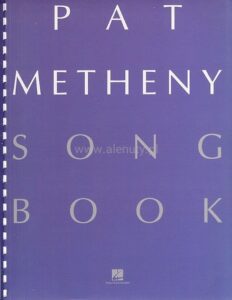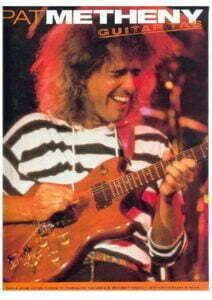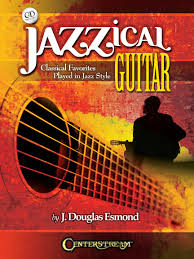Come join us now, and enjoy playing your beloved music and browse through great scores of every level and styles!
Can’t find the songbook you’re looking for? Please, email us at: sheetmusiclibrarypdf@gmail.com We’d like to help you!
Table of Contents
Pat Metheny and Lyle Mays – September Fifteenth (live) – From ‘Imaginary Day Live’ (1998)
Dedicated to the death of Bill Evans (September 15, 1980)
“Imaginary Day Live” was filmed and recorded live at The Mountain Winery in Saratoga, California on July 21-23, 1998. The unbelievable performance by the Pat Metheny Band is futher evidence that Metheny is keeping the flame burning for his special brand of jazz music. Joining guitarist Metheny are keyboardist Lyle Mays, bassist Steve Rodby, drummer Paul Wertico, vocalist/guitarist Mark Ledford, vocalist/guitarist Philip Hamilton and percussionist Jeff Haynes.

Best Sheet Music download from our Library.

Please, subscribe to our Library.
If you are already a subscriber, please, check our NEW SCORES’ page every month for new sheet music. THANK YOU!
https://www.facebook.com/reel/1006139023072167
Pat Metheny Group – Imaginary Day Live “98 01. Into the Dream 02. Follow Me 03. A Story Within The Story 04. Imaginary Day 05. Heat of the Day 06. Across the Sky 07. The Roots of Coincidence 08. Message to a Friend 09. September Fifteenth 10. Minuano (Six Eight) Pat Metheny (acoustic, electric & synth guitar) Lyle Mays (acoustic piano, keyboards, guitar) Steve Rodby (acoustic & electric bass) Paul Wertico (drums) Mark Ledford (vocals, trumpet, percussion, guitar) Philip Hamilton (vocals, percussion, guitar) Jeff Haynes (percussion)

Browse in the Library:
Or browse in the categories menus & download the Library Catalog PDF:
The Alchemy of Sound: The Musical Universe of Pat Metheny and Lyle Mays
The Pat Metheny Group was more than a band; it was a world. A world with its own sonic landscapes, from the wide-open plains of American heartland rock to the intricate labyrinths of modern jazz and the lush, orchestral tapestries of Brazilian music. At the heart of this world for over three decades was one of the most celebrated and symbiotic partnerships in modern music: the collaboration between guitarist Pat Metheny and pianist/keyboardist Lyle Mays. Together, they were not just co-leaders but co-composers and co-architects of a unique sound that blended virtuosic improvisation with complex, through-composed structures.
Part 1: The Guitarist – Pat Metheny
Biography:
Born on August 12, 1954, in Lee’s Summit, Missouri, Pat Metheny was a prodigy. He began on trumpet but switched to guitar after being mesmerized by the Beatles on television. His talent developed at an astonishing rate. By the age of 15, he was winning scholarships and jamming with jazz legends passing through Kansas City.
A pivotal moment came when he attended a summer music camp directed by the great vibraphonist Gary Burton. Burton was so impressed that he invited the 18-year-old Metheny to join his band, making him the youngest teacher ever at the Berklee College of Music shortly after. With Burton, Metheny honed his signature sound—a warm, smooth, legato tone, often compared to a singer’s voice, using a Gibson ES-175 guitar and minimal amplification.
His solo debut, Bright Size Life (1976), is a landmark album that announced a new voice on the instrument. Featuring the revolutionary bassist Jaco Pastorius and drummer Bob Moses, the record redefined the jazz guitar trio with its lyrical melodicism, open harmonies, and breathtaking interplay. It was clear that Metheny was not just a brilliant technician but a visionary with a distinct artistic concept waiting to be fully realized.
Part 2: The Architect – Lyle Mays
Biography:
Lyle Mays was born on November 27, 1953, in Wausaukee, Wisconsin. A true polymath, he showed equal aptitude for music and mathematics from a young age. He studied classical piano extensively but was also deeply drawn to the harmonic sophistication of jazz, particularly the work of Bill Evans and Keith Jarrett.
Like Metheny, he attended the University of North Texas (then North Texas State University), where he composed for and arranged for the renowned One O’Clock Lab Band. His academic background gave him a formidable command of music theory, composition, and orchestration. Mays was not just a pianist; he was a composer who thought in terms of large-scale form, counterpoint, and texture. When he met Metheny in 1974 while both were playing with vibraphonist Gary Burton, the connection was immediate. They recognized in each other a shared love for expansive, genre-blurring music.
Part 3: The Partnership – Building a Group Sound
In 1977, with the encouragement of ECM Records producer Manfred Eicher, Metheny formed the first iteration of the Pat Metheny Group. He knew that to realize the grand musical visions he had, he needed a co-conspirator of equal ambition and complementary skills. Lyle Mays was the obvious and only choice.
Their partnership was a perfect alchemy of their respective strengths:
- Metheny was the Melodist and Sound Explorer: He provided the core melodic identity. His guitar sound—often using the Roland GR-300 guitar synthesizer for soaring, orchestral leads—became the group’s primary voice. He was also the bandleader, the charismatic frontman with an unwavering belief in their collective vision.
- Mays was the Harmonic and Textural Architect: He provided the complex harmonic foundation and the intricate arrangements. His piano was the internal engine of the group, while his array of keyboards (especially Oberheim and Prophet synthesizers) painted the vast atmospheric backdrops. He was the master of color, creating shimmering pads and intricate sequencer patterns that gave the music its cinematic quality.
Their compositional process was deeply collaborative. A piece could start with a melodic fragment from Metheny, which Mays would then harmonize and develop, or it could begin with a complex chord progression from Mays, over which Metheny would craft a soaring theme. They shared composing credits on almost all of the group’s original music, a rarity in jazz where individual songwriting is often prized.
The Evolution of a Sound: Key Albums
The group’s discography charts the evolution of their shared vision:
- The Early Acoustic Years (1978-1980): Albums like Pat Metheny Group (1978) and American Garage (1979) established their signature blend of jazz improvisation and accessible, rock-influenced energy. Tunes like “Phase Dance” and “(Cross the) Heartland” showcased the seamless interplay between Metheny’s guitar and Mays’ piano and keyboards, set against a backdrop of rhythmic drive from bassist Mark Egan and drummer Dan Gottlieb.
- The Orchestral Breakthrough: Offramp (1982): The addition of bass virtuoso Steve Rodby (who would become a permanent anchor) and percussionist Naná Vasconcelos marked a major expansion. The album’s centerpiece, “Are You Going With Me?”, is a quintessential Metheny/Mays work: a simple, hypnotic melody from Metheny’s guitar synth, built over a lush, slowly unfolding harmonic landscape crafted by Mays, culminating in a breathtakingly beautiful guitar solo.
- The Masterpiece: Still Life (Talking) (1987): This album perfected their fusion of jazz and Brazilian influences, creating a sound that was both globally popular and artistically profound. Tracks like “Minuano (Six Eight)” and “Last Train Home” are masterclasses in composition. The latter, with its iconic train-beat rhythm and wistful melody, became an anthem. Mays’ arrangements here are sublime, using the wordless vocals of Pedro Aznar as an integral textural element.
- The Epic Scale: The Road to You (1993) & We Live Here (1995): These albums showcased a bigger, more produced sound, incorporating elements of funk and pop while retaining their compositional complexity. Mays’ role became even more central, orchestrating dense layers of keyboards and synthesizers to create a powerful, immersive live experience.
The End of an Era and Lasting Legacy
Lyle Mays was famously introspective and less comfortable with the demands of the music industry. After the group’s final album, The Way Up (2005)—a sprawling, single-piece suite that was the apex of their large-scale compositional ambitions—he gradually withdrew from touring and recording. He passed away on February 10, 2020, after a long illness.
Pat Metheny has continued a prolific and diverse solo career, but he has always acknowledged that the partnership with Mays was foundational. The music they created together stands as a unique monument in late 20th-century music.
Their Enduring Legacy:
- Genre Fusion: They successfully and authentically blended jazz, rock, world music, and classical forms into a cohesive and accessible whole, expanding the audience for jazz without compromising artistic integrity.
- Compositional Ambition: They proved that a “jazz group” could be a vehicle for sophisticated, through-composed works as complex as any classical chamber music, while still leaving ample room for brilliant improvisation.
- The Gold Standard for Collaboration: Their partnership remains a benchmark for musical synergy. It was a relationship built on mutual respect, shared ambition, and complementary genius—a rare alchemy that created a soundworld so complete it could only have come from the two of them together.
In the end, the story of Pat Metheny and Lyle Mays is the story of a conversation. It was a conversation that began in 1974 and lasted over thirty years, a dialogue of melody and harmony, simplicity and complexity, heartland and horizon, captured forever on record for the world to hear.
